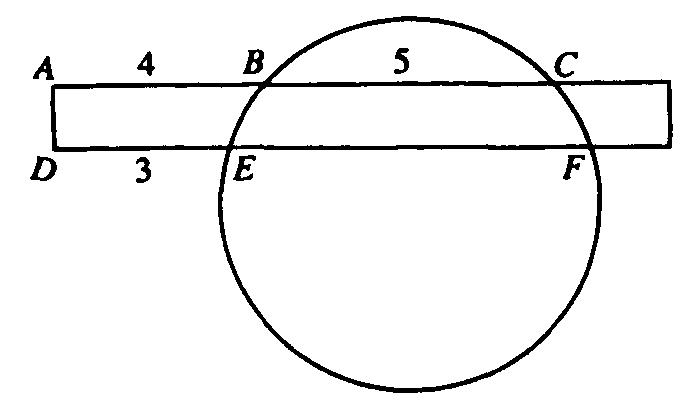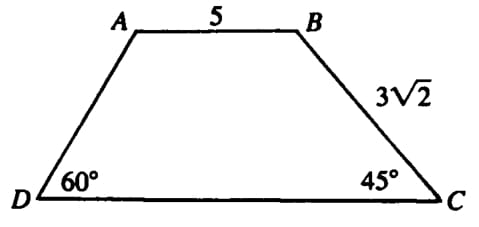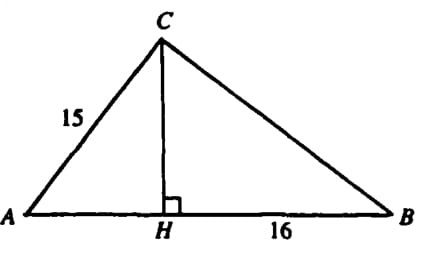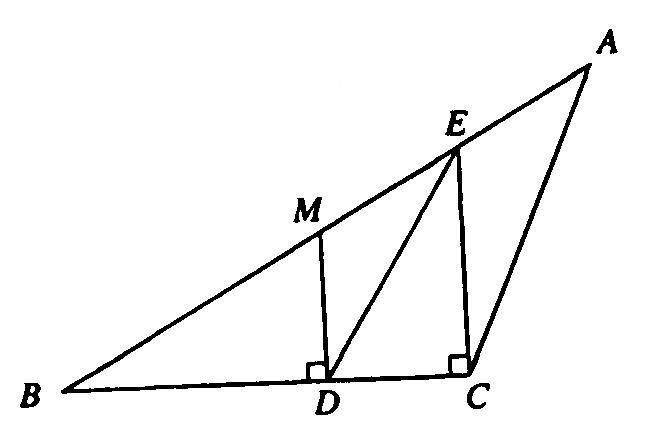Difference between revisions of "1984 AHSME Problems"
m (Further fixed Problem 25) |
(Fixed Problem 26) |
||
| Line 197: | Line 197: | ||
==Problem 26== | ==Problem 26== | ||
| − | In the [[obtuse triangle]] <math> ABC | + | In the [[obtuse triangle]] <math> ABC </math>, <math> AM=MB </math>, <math> MD\perp BC </math>, <math> EC\perp BC </math>. If the [[area]] of <math> \triangle ABC </math> is <math> 24 </math>, then the area of <math> \triangle BED </math> is |
| − | <math> \mathrm{(A) \ }9 \qquad \mathrm{(B) \ }12 \qquad \mathrm{(C) \ } 15 \qquad \mathrm{(D) \ }18 \qquad \mathrm{(E) \ } \text{ | + | [[File:AHSME-1984-Q26.jpg]] |
| + | |||
| + | <math> \mathrm{(A) \ }9 \qquad \mathrm{(B) \ }12 \qquad \mathrm{(C) \ } 15 \qquad \mathrm{(D) \ }18 \qquad \mathrm{(E) \ } \text{not uniquely determined} </math> | ||
[[1984 AHSME Problems/Problem 26|Solution]] | [[1984 AHSME Problems/Problem 26|Solution]] | ||
Revision as of 09:47, 27 October 2018
Contents
[hide]- 1 Problem 1
- 2 Problem 2
- 3 Problem 3
- 4 Problem 4
- 5 Problem 5
- 6 Problem 6
- 7 Problem 7
- 8 Problem 8
- 9 Problem 9
- 10 Problem 10
- 11 Problem 11
- 12 Problem 12
- 13 Problem 13
- 14 Problem 14
- 15 Problem 15
- 16 Problem 16
- 17 Problem 17
- 18 Problem 18
- 19 Problem 19
- 20 Problem 20
- 21 Problem 21
- 22 Problem 22
- 23 Problem 23
- 24 Problem 24
- 25 Problem 25
- 26 Problem 26
- 27 Problem 27
- 28 Problem 28
- 29 Problem 29
- 30 Problem 30
- 31 See also
Problem 1
![]() equals
equals
![]()
Problem 2
If ![]() , and
, and ![]() are not
are not ![]() , then
, then
![]() equals
equals
![]()
Problem 3
Let ![]() be the smallest nonprime integer greater than
be the smallest nonprime integer greater than ![]() with no prime factor less than
with no prime factor less than ![]() . Then
. Then
![]()
Problem 4
A rectangle intersects a circle as shown: ![]() ,
, ![]() and
and ![]() . Then
. Then ![]() equals
equals

![]()
Problem 5
The largest integer ![]() for which
for which ![]() is
is
![]()
Problem 6
In a certain school, there are three times as many boys as girls and nine times as many girls as teachers. Using the letters ![]() to represent the number of boys, girls and teachers, respectively, then the total number of boys, girls and teachers can be represented by the expression
to represent the number of boys, girls and teachers, respectively, then the total number of boys, girls and teachers can be represented by the expression
![]()
Problem 7
When Dave walks to school, he averages ![]() steps per minute, each of his steps
steps per minute, each of his steps ![]() cm long. It takes him
cm long. It takes him ![]() minutes to get to school. His brother, Jack, going to the same school by the same route, averages
minutes to get to school. His brother, Jack, going to the same school by the same route, averages ![]() steps per minute, but his steps are only
steps per minute, but his steps are only ![]() cm long. How long does it take Jack to get to school?
cm long. How long does it take Jack to get to school?
![]()
Problem 8
Figure ![]() is a trapezoid with
is a trapezoid with ![]() ,
, ![]() ,
, ![]() ,
, ![]() and
and ![]() . The length of
. The length of ![]() is
is
![]()
Problem 9
The number of digits in ![]() (when written in the usual base
(when written in the usual base ![]() form) is
form) is
![]()
Problem 10
Four complex numbers lie at the vertices of a square in the complex plane. Three of the numbers are ![]() and
and ![]() . The fourth number is
. The fourth number is
![]()
Problem 11
A calculator has a key that replaces the displayed entry with its square, and another key which replaces the displayed entry with its reciprocal. Let ![]() be the final result when one starts with an entry
be the final result when one starts with an entry ![]() and alternately squares and reciprocates
and alternately squares and reciprocates ![]() times each. Assuming the calculator is completely accurate (e.g. no roundoff or overflow), then
times each. Assuming the calculator is completely accurate (e.g. no roundoff or overflow), then ![]() equals
equals
![]()
Problem 12
If the sequence ![]() is defined by
is defined by
![]()
![]()
then ![]() equals
equals
![]()
Problem 13
![]() equals
equals
![]()
![]()
Problem 14
The product of all real roots of the equation ![]() is
is
![]()
Problem 15
If ![]() , then one value for
, then one value for ![]() is
is
![]()
Problem 16
The function ![]() satisfies
satisfies ![]() for all real numbers
for all real numbers ![]() . If the equation
. If the equation ![]() has exactly four distinct real roots, then the sum of these roots is
has exactly four distinct real roots, then the sum of these roots is
![]()
Problem 17
A right triangle ![]() with hypotenuse
with hypotenuse ![]() has side
has side ![]() . Altitude
. Altitude ![]() divides
divides ![]() into segments
into segments ![]() and
and ![]() , with
, with ![]() . The area of
. The area of ![]() is
is
![]()
Problem 18
A point ![]() is to be chosen in the coordinate plane so that it is equally distant from the
is to be chosen in the coordinate plane so that it is equally distant from the ![]() -axis, the
-axis, the ![]() -axis, and the line
-axis, and the line ![]() . Then
. Then ![]() is
is
![]()
Problem 19
A box contains ![]() balls, numbered
balls, numbered ![]() . If
. If ![]() balls are drawn simultaneously at random, what is the probability that the sum of the numbers on the balls drawn is odd?
balls are drawn simultaneously at random, what is the probability that the sum of the numbers on the balls drawn is odd?
![]()
Problem 20
The number of the distinct solutions of the equation ![]() is
is
![]()
Problem 21
The number of triples ![]() of positive integers which satisfy the simultaneous equations
of positive integers which satisfy the simultaneous equations
![]()
![]()
is
![]()
Problem 22
Let ![]() and
and ![]() be fixed positive numbers. For each real number
be fixed positive numbers. For each real number ![]() let
let ![]() be the vertex of the parabola
be the vertex of the parabola ![]() . If the set of the vertices
. If the set of the vertices ![]() for all real values of
for all real values of ![]() is graphed on the plane, the graph is
is graphed on the plane, the graph is
![]()
Problem 23
![]() equals
equals
![]()
Problem 24
If ![]() and
and ![]() are positive real numbers and each of the equations
are positive real numbers and each of the equations ![]() and
and ![]() has real roots, then the smallest possible value of
has real roots, then the smallest possible value of ![]() is
is
![]()
Problem 25
The total area of all the faces of a rectangular solid is ![]() , and the total length of all its edges is
, and the total length of all its edges is ![]() . Then the length in cm of any one of its interior diagonals is
. Then the length in cm of any one of its interior diagonals is
![]()
Problem 26
In the obtuse triangle ![]() ,
, ![]() ,
, ![]() ,
, ![]() . If the area of
. If the area of ![]() is
is ![]() , then the area of
, then the area of ![]() is
is
![]()
Problem 27
In ![]() ,
, ![]() is on
is on ![]() and
and ![]() is on
is on ![]() . Also,
. Also, ![]() ,
, ![]() , and
, and ![]() . Find
. Find ![]() .
.
![]()
Problem 28
The number of distinct pairs of integers ![]() such that
such that ![]() and
and ![]() is
is
![]()
Problem 29
Find the largest value for ![]() for pairs of real numbers
for pairs of real numbers ![]() which satisfy
which satisfy ![]() .
.
![]()
Problem 30
For any complex number ![]() ,
, ![]() is defined to be the real number
is defined to be the real number ![]() . If
. If ![]() , then
, then
![]()
equals
![]()
See also
| 1984 AHSME (Problems • Answer Key • Resources) | ||
| Preceded by 1983 AHSME |
Followed by 1985 AHSME | |
| 1 • 2 • 3 • 4 • 5 • 6 • 7 • 8 • 9 • 10 • 11 • 12 • 13 • 14 • 15 • 16 • 17 • 18 • 19 • 20 • 21 • 22 • 23 • 24 • 25 • 26 • 27 • 28 • 29 • 30 | ||
| All AHSME Problems and Solutions | ||
The problems on this page are copyrighted by the Mathematical Association of America's American Mathematics Competitions. ![]()












